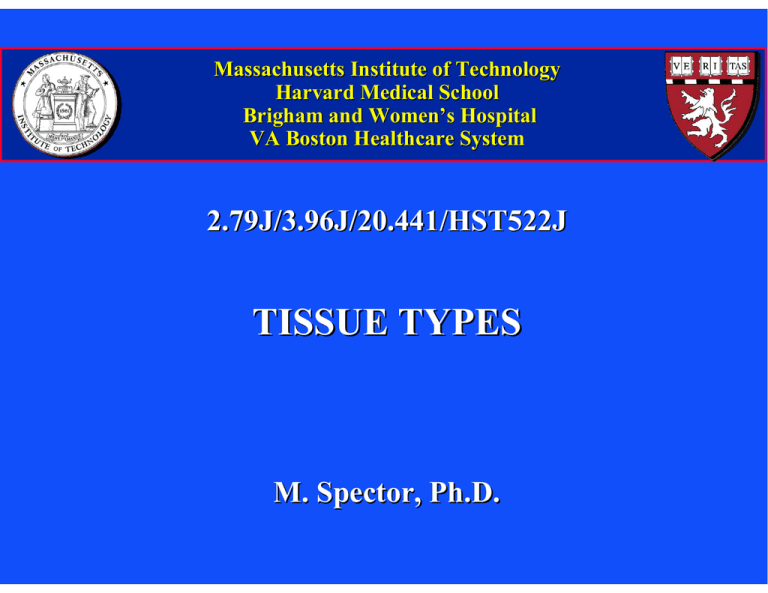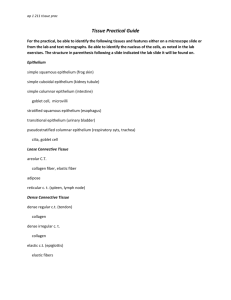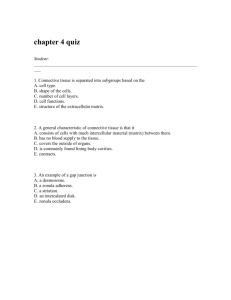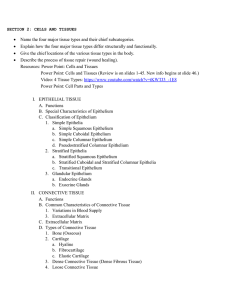Massachusetts Institute of Technology Harvard Medical School Brigham and Women ’
advertisement

Massachusetts Institute of Technology Harvard Medical School Brigham and Women’s Hospital VA Boston Healthcare System 2.79J/3.96J/20.441/HST522J 2.79J/3.96J/20.441/HST522J TISSUE TYPES TYPES M. Spector, Ph.D. Ph.D. DEFINITIONS On-line Medical Dictionaries http://cancerweb.ncl.ac.uk/omd/ http://medicaldictionary.thefreedictionary.com/ The Cell and Its Membrane Molecules Figures by MIT OpenCourseWare. http://www.ns.purchase.edu/biology/bio1560lab/histology-1.htm Viewing Histological Sections Effects of the Plane of Sectioning Figure by MIT OpenCourseWare. TISSUE CLASSIFICATION Connective Tissue Epithelia Muscle Nerve TISSUE CLASSIFICATION Connective Tissue Epithelia Muscle Nerve Extracellular matrix continuous; and in some tissues also cell continuous Cell continuous Muscle and nerve cells are surrounded by a basal lamina Basal epithelial cells are attached to a basement membrane Basal lamina=basement membrane BASEMENT MEMBRANE Continuous sheet, 50-300 nm thick No cells contained within the BM; it is a nonliving structure Principal protein constituents Laminin Type IV collagen Type XVIII collagen L. Jeng Basement Membrane Diagram removed due to copyright restrictions. FASEB J 2005 Image removed due to copyright restrictions. Diagrams of muscle, epithelial sheet, and kidney glomerulus structures. B Alberts, et al, Mol Biol of the Cell, p. 819 (1989) Scanning Electron Micrograph of the Cornea of a Chick Embryo E: Epithelial cells BL: Basal lamina C: Collagen fibrils in the underlying CT Photo removed due to copyright restrictions. B Alberts, et al, Mol Biol of the Cell, p. 819 (1989) Connective Tissue Image removed due to copyright restrictions. Sketches from Illustrated Physiology, AB McNaught and R Callander, Williams and Wilkins, 1967 Connective Tissues Image removed due to copyright restrictions. See http://cal.vet.upenn.edu/projects/histo/Index.htm Loose and dense connective tissue from a cow's planum. Loose Connective Tissue Dense Connective Tissue Images removed due to copyright restrictions. Ciba Collection, FH Netter, 1987 Connective Tissue: Adipose Tissue (Fat) Images removed due to copyright restrictions. Connective Tissue: Bone Image removed due to copyright restrictions. Ciba Collection, FH Netter, 1987 Connective Tissue: Cartilage Hyaline Cartilage: Trachea Elastic Cartilage: Epiglottus Image removed due to copyright restrictions. See http://cal.vet.upenn.edu/projects/histo/Index.htm Fibrocartilage Cartilage identification is principally based on morphology; rounded cells in a lacuna; ECM is type I collagen (fibrocartilage) or type II cartilage (hyaline), with (elastic) or without elastin. http://www.uoguelph.ca/zoology/devobio/210labs/epithelial1.html Simple Squamous Epithelium (chick blastodisc at about 33 hours of incubation ) Top View Cross-Sectional View Simple squamous epithelium, which generally occurs as a thin sheet-like layer allowing for minimal resistance to diffusion, is also been called "pavement” epithelium, because it can look like like paving stones as seen from above. Examples include the linings of the peritoneal, pleural and pericardial cavities. Other places simple squamous epithelium can be found include: the glomerulus of the kidney, the walls of capillaries, and the alveoli of the lungs. http://www.uoguelph.ca/zoology/devobio/210labs/epithelial1.html Simple Cuboidal Epithelium (collecting ducts in the medulla of a mammalian kidney) This type of epithelium is thicker than simple simple squamous epithelium, so it does not allow for passive diffusion as readily. http://www.uoguelph.ca/zoology/devobio/210labs/epithelial1.html Simple Columnar Epithelium (small intestine) Since columnar cells are quite thick, they do not readily allow passive diffusion. As a result, these cells use active transport to move nutrients through them from the intestine to the blood. This is what we commonly call "absorption." To help with this, they have numerous microvilli on their apical (lumenal) surface, which increases their surface area to allow for greater absorption. Simple Columnar Epithelium Image removed due to copyright considerations. See http://cal.vet.upenn.edu/projects/histo/Index.htm This is a section through the edge of a gallbladder. There is a layer of simple columnar epithelium overlying the connective tissue as indicated by the arrows. Stratified Squamous Epithelium Image removed due to copyright restrictions. See http://cal.vet.upenn.edu/projects/histo/Index.htm This is an example of stratified squamous epithelium from the esophagus of a cat. Arrows show nuclei of the outermost layer. This is normal for mucosa. Most stratified squamous cells in other areas, such as skin, lose their nuclei by the time they approach the outermost layers. http://www.uoguelph.ca/zoology/devobio/210labs/epithelial1.html Stratified Squamous Epithelium (epidermis) The cells of the basal layer of the epidermis (closest to the dermis) are cuboidal to columnar in shape. These cells are actively mitotic, producing new cells that get pushed upward into the overlying layers. As these cells are pushed up, they become flatter and longer taking on the typical squamous shape. When the cells reach the top, they are sloughed off and replaced by cells from below. The dermis which underlies the epidermis is composed of a dense, irregular connective tissue, which we will see again later. Pseudostratified Columnar Epithelium Image removed due to copyright restrictions. See http://cal.vet.upenn.edu/projects/histo/Index.htm This is an example of ciliated pseudostratified columnar epithelium from the trachea. The arrows indicate the layer of cilia on the surface of the pseudostratified columnar cell layer. Intestinal Epithelium Photos removed due to copyright restrictions. BM: Lu: Cp: Co: SM: M: NF: basement membrane lumen capillary collagen fibrils smooth muscle cell mitochondria nerve fibers 1μm KR Porter & MA Bonneville, Fine Structure of Cells and Tissues (1973) Ciliated Epithelium Photo removed due to copyright restrictions. C: SER: F: El: cilia vesicles fibroblasts elastic fibers 1μm KR Porter & MA Bonneville, Fine Structure of Cells and Tissues (1973) Convoluted Tubule of the Kidney: Epithelium Photo removed due to copyright restrictions. 1μm KR Porter & MA Bonneville, Fine Structure of Cells and Tissues (1973) SEM of the Kidney Photo removed due to copyright restrictions. KR Porter & MA Bonneville, Fine Structure of Cells and Tissues (1973) 20μm Kidney: Epithelium Photo removed due to copyright restrictions. US: urinary space KR Porter & MA Bonneville, Fine Structure of Cells and Tissues (1973) 0.3 μm Transmission Electron Micrograph of a Rat Kidney Glomerulus Photo removed due to copyright restrictions. From R Kessel and R. Kardon, Tiss and Org, p.233 (1979) Muscle Drawings removed due to copyright restrictions. 1. Smooth muscle 2. Cardiac muscle 3. Voluntary muscle fiber. Ciba Collection, FH Netter, 1987 http://www.uoguelph.ca/zoology/devobio/210labs/epithelial1.html Muscle Smooth (Involuntary) Muscle Cardiac Muscle Striated (Skeletal; Vountary) Muscle Cardiac Muscle Photo removed due to copyright restrictions. SC: Schwann cell CT: connective tissue 0.3 μm KR Porter & MA Bonneville, Fine Structure of Cells and Tissues (1973) Nerve Figure by MIT OpenCourseWare. After McNaught and Callander, Illustrated Physiology, Williams and Wilkins, 1967. http://www.uoguelph.ca/zoology/devobio/210labs/epithelial1.html Nerve An isolated nerve cell - neuron (large arrow) - from a mammalian spinal cord showing and the nuclei of the surrounding neuroglial cells (small arrows). Note the numerous cytoplasmic extensions emanating from the neuronal cell body and the size of the neuron compared with the neuroglial cells. Peripheral Nerve: Rat Sciatic Photo removed due to copyright restrictions. Molecular Cell Biology, J Darnell, et al., 1990 Nerve Image removed due to copyright considerations. See http://cal.vet.upenn.edu/projects/histo/Index.htm This is a myelinated nerve from the thoracic wall. A indicates the myelin sheath around the actual nerve fibers (B). Peripheral Nerve Photo removed due to copyright restrictions. 0.3 μm KR Porter & MA Bonneville, Fine Structure of Cells and Tissues (1973) Diagram removed due to copyright restrictions. Flow chart from ovum fertilization through cleavage, blastulation, implantation, and beginnings f tissue differentiation. Embryonic Stem Cells Embryonic Germ Disc • Ectoderm becomes: – Epithelia of external surfaces – Nervous system tissues • Mesoderm becomes: – – – – Muscular tissues Connective tissues Urogenital system Lining of body cavities and blood vessels • Endoderm becomes: – Epithelia of most internal surfaces – Some glands (e.g. thyroid, pancreas, liver) MIT OpenCourseWare http://ocw.mit.edu 20.441J / 2.79J / 3.96J / HST.522J Biomaterials-Tissue Interactions Fall 2009 For information about citing these materials or our Terms of Use, visit: http://ocw.mit.edu/terms.







